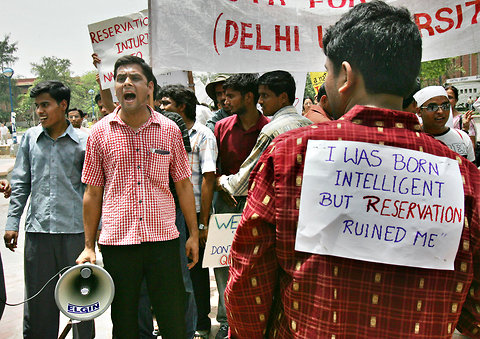A study by Surjit Bhalla, Arvind Virmani and Karan Bhasin estimates that extreme poverty — defined by the World Bank as consumption below $1.90 per day per person — has virtually disappeared in India. India’s poverty line is virtually identical to the Bank’s. The new study adapts a Bank methodology. It concludes that the poverty ratio fell sharply from 31.9% in 2004 to 5.1% in 2014 and 0.86% in 2020.
Critics will slam this methodology, which bypasses data from the 2017-18 NSSO survey. But some other studies also show sharply falling poverty in recent decades.
This column will not discuss these poverty studies. But if poverty is falling sharply without job or educational quotas for economically weaker sections (EWS), does that not weaken the government’s legal case on the 2019 law providing a 10% EWS quota? The Supreme Court rejected an EWS quota a s unwarranted in 1992 when a big chunk of the population was under the poverty line. Can such a quota be warranted today when by any estimate poverty is vastly lower?
The Constitution prohibits discrimination based on caste, religion, gender, or place of birth. It nevertheless allows job and educational quotas as reverse discrimination for Dalits and tribals who have suffered deep historical discrimination that now requires a temporary period of reverse discrimination. The Constitution also permits reservations for economically and socially backward classes. Politically powerful groups, including caste-based parties, have demanded and got quotas by equating OBCs (other backward castes) with the constitutionally permitted “backward classes”.
In 1991, the government issued orders for a quota of 27% for OBCs and another 10% for EWS. The Supreme Court struck down the EWS quota as unrelated to historical disability but upheld the OBC quota. Along with the 15% quota for Dalits and 7.5% for tribals, 49.5% of all jobs were now reserved. Anything more, said the court, would not be compatible with the principle of non-discrimination.
However, India’s job crisis runs deep, spurring demands for more that are politically difficult to resist. Central and state governments provide the bulk of formal sector jobs. Government jobs are prized since they provide total job security. Bihar suffered riots for three days last January over alleged unfairness in exams for 35,000 Railway jobs for which 10 million people applied. In 2016 in Amroha town, 17,000 people (including some with MBA and BTech degrees) applied for 114 posts of sweepers.
The job crisis arises from a terrible educational system that produces unemployable school and college graduates lacking functional skills. That is an outrage. But it cannot be solved through quotas, which merely postpone educational reforms.
All parties voted for the 10% quota for EWS. The BJP boasted that the new quota for the first time gave access to quotas for Muslims and Christians. Clearly politicians see quotas as a way of winning votes rather than reversing discrimination.
The government defines EWS as those with a family income below ₹8 lakh/year, farmland below five acres, and urban property below 1,000 sq ft. The 2011-12 NSSO report says the per capita spending of the richest 5% of Indians was just ₹4,481 in rural areas and ₹10,281 in urban areas. Per capita income may have been 20% more. The 2011 Socio-Economic Caste Census said only 8.25% rural households earned more than ₹10,000 per month. Incomes have risen since, yet these suggest that more than 80% of Indians will qualify for EWS quotas. That is a farce unrelated to historical discrimination.
The 2015-16 Agriculture Census revealed that 86% of landholdings were under five acres. All qualify for EWS. This again is farcical. Clearly the EWS quota aims to cover as possible, not the weakest, to win the maximum votes. This is politics at its brazen best and is a good reason for the Supreme Court to strike down the quota.
Dalits, tribals and OBCs were given quotas as a form of reverse discrimination. But poverty among upper castes is not the consequence of historical discrimination. They have historically been oppressors, not victims. Some may have become poor through gambling or drug problems, death of breadwinners, medical emergencies or natural disasters. Such families deserve help. But the world over such help does not include quotas.
Even with quotas, minimum marks are needed to get a seat in JNU or the IAS. The poorest are barely literate and would never come close to getting the minimum marks. The beneficiaries will mainly be the creamy layer — upper-caste people rendered temporarily poor by financial shocks but otherwise part of the upper social structure. Some will be rich crooks hiding their wealth.
The Supreme Court should not aid them. Rather, it should tell the government that educational reform rather than quotas is the solution to the job crisis.
This article was originally published in The Times of India on April 9, 2022.


